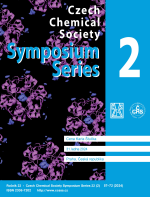Lipidomická analýza makrofágů metodou LC-MS
DOI:
https://doi.org/10.54779/ccsss20240066Klíčová slova:
makrofágy, lipidomika, kapalinová chromatografie, hmotnostní spektrometrieAbstrakt
Currently, an increasing incidence of cardiovascular diseases is observed in the population. Factors contributing to their development are obesity and pro-inflammatory processes occurring in the adipose tissue. Macrophages, cells of the non-specific immune system, which can be divided into pro-inflammatory and anti-inflammatory, play a significant role in these processes. For a better understanding of these phenomena, it is necessary to analyze the lipidome of macrophages of the two mentioned groups. The presented work was focused on the optimization of selected parameters of the LC-MS method for the analysis of 71 lipids from 16 lipid classes. Best results were achieved with column Acquity UPLC BEH C18 (1.7 µm, 2.1 mm × 100 mm) operating at the flow rate of 300 μL min–1 and temperature of 55 °C. The optimal desolvation temperature was 350 °C and the gradient elution started at 0 % of solvent B in the mobile phase. Retention dependencies were characterized for individual lipid classes. They were successfully fitted with a linear model (R2 > 0.99) and subsequently used to confirm the accuracy of lipid identification. The optimized LC-MS method was also used to analyze the real samples of macrophages isolated from the adipose tissue of kidney donors. Samples were provided by Institute for Clinical and Experimental Medicine. The principal component analysis gave insight into the division of macrophages according to their type. The volcano plot showed a significant increase in the concentration of five lipids in the case of pro-inflammatory macrophages.




